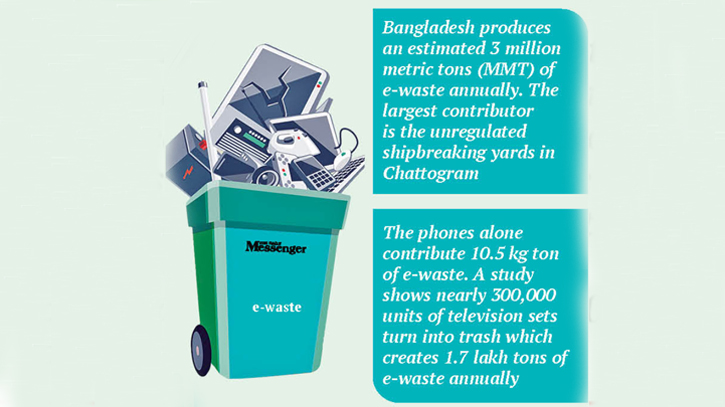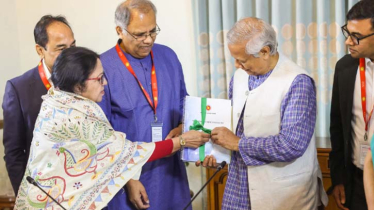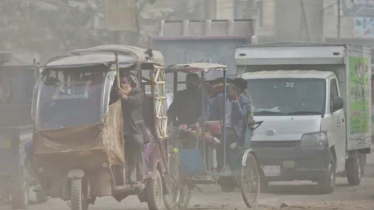
Photo: Messenger
In the last few decades, the phenomenal rise of e-waste has alarmed environmentalists and NGOs and caused headaches for government agencies.
The intensification of the use of electronic products including microchips, automated machines, household appliances, office equipment, transport systems, and industrial tools, not to speak of laptops, computers, printers, and smartphones.
E-waste production is rising by 30 percent annually.
When the electronic products and tools lifecycle comes to an end, they are disposed of as municipal solid waste (MSW).
The practices not only threaten the environment but also have an immense impact on human health.
Bangladesh produces an estimated 3 million metric tons (MMT) of e-waste annually. The largest contributor is the unregulated shipbreaking yards in Chattogram.
In the country, mobile phones and smartphones contribute significant e-waste in rural, small towns and of course cities.
There are now 130 million mobile phone users in the country. The figure was 20 million in 2006.
At the national level, 41,433,742 households have at least one mobile phone. Among the phones, 22,193,311 are smartphones and 325,580 landlines.
The phones alone contribute 10.5 kg ton of e-waste. A study shows nearly 300,000 units of television sets turn into trash which creates 1.7 lakh tons of e-waste annually. While the shipbreaking industries produce 25 lakh tons of e-waste.
Most of the e-waste disposed of as garbage and trash end up in landfills, water-bodies, drains, rivers, and canals. Only 15 percent of the Dhaka metropolis's 475 tons per day of inorganic e-waste is recycled.
The system of managing e-waste in Bangladesh is very clumsy. Lack of public awareness has been attributed to dumping e-waste in unofficial collection centers.
Most of the e-waste is burned, not in incinerators but in open landfills emitting greenhouse gases.
Except for vehicle batteries, household appliances, like refrigerators, washing machines, and microwaves are bought back by sales centers. The rest of the products are bought by informal collection agents.
Reuse of e-waste is very common nowadays with sales of computers, laptops, and printers bought by vendors. The vendors do not accept computer accessories and other similar products that do not have value in the recycling market.
An estimated 63.37 percent of e-waste in the capital Dhaka is resold to customers after the products mainly computers, laptops, and printers are refurbished.
The refurbished products are cheaper and customers, mostly the electronic machines are bought and sold by students and middle-class customers.
Nearly, 20 to 30 percent of the electric and electronic products are recycled.
Unfortunately, the electric and electronic wastes are recycled and refurbished in Dhaka and major city markets where computers and laptops are sold and bought do not follow any standards, like after-sales service and warranty.
Most of the refurbished are sold on online platforms. Most of the customers who buy from online markets are thoroughly cheated and the return policy is unregulated. The sellers do not commit to the customers when the refurbished products are not working.
The primary victims, as Tanjima Hoque Trisha, a researcher with VOICE Bangladesh said that exposure to e-waste are children and women.
Fifty thousand children are engaged in unauthorized e-waste collection and recycling processes in the country. They are highly exposed to e-waste-derived chemicals and wastes from landfill sites.
There is a high risk in handling e-waste in recycling facilities since they are unaware of the hazards of handling e-waste and have less practice of using personal protective equipment (PPE) to shield themselves.
In their workplaces, chemical risk analysis (CRA), task risk analysis (TRA), or health risk analysis (HRA) are not appropriately assessed.
Electronic waste contains components (metal and chemicals) that are dangerous to human health. This includes mercury, lead, polybrominated flame retardants, cadmium, barium, and lithium.
These toxins can damage the skeletal, nervous, and reproductive systems of the human body which can lead to diseases and birth defects.
Eventually, these effects can damage human blood, kidneys central and peripheral nervous systems.
The e-waste can also affect attention deficit or hyperactivity disorder (ADHD), behavioral problems, changes in child temperament, and sensory integration difficulties.
Environmentalists and NGOs in Bangladesh have been demanding a national policy and legislation to protect the public from the impact of e-waste hazards on public health.
Unfortunately, the Environment Ministry and Industries Ministry have not developed a comprehensive plan for a national policy on e-waste. A draft plan is lying in cold storage for a few years.
Messenger/Disha








